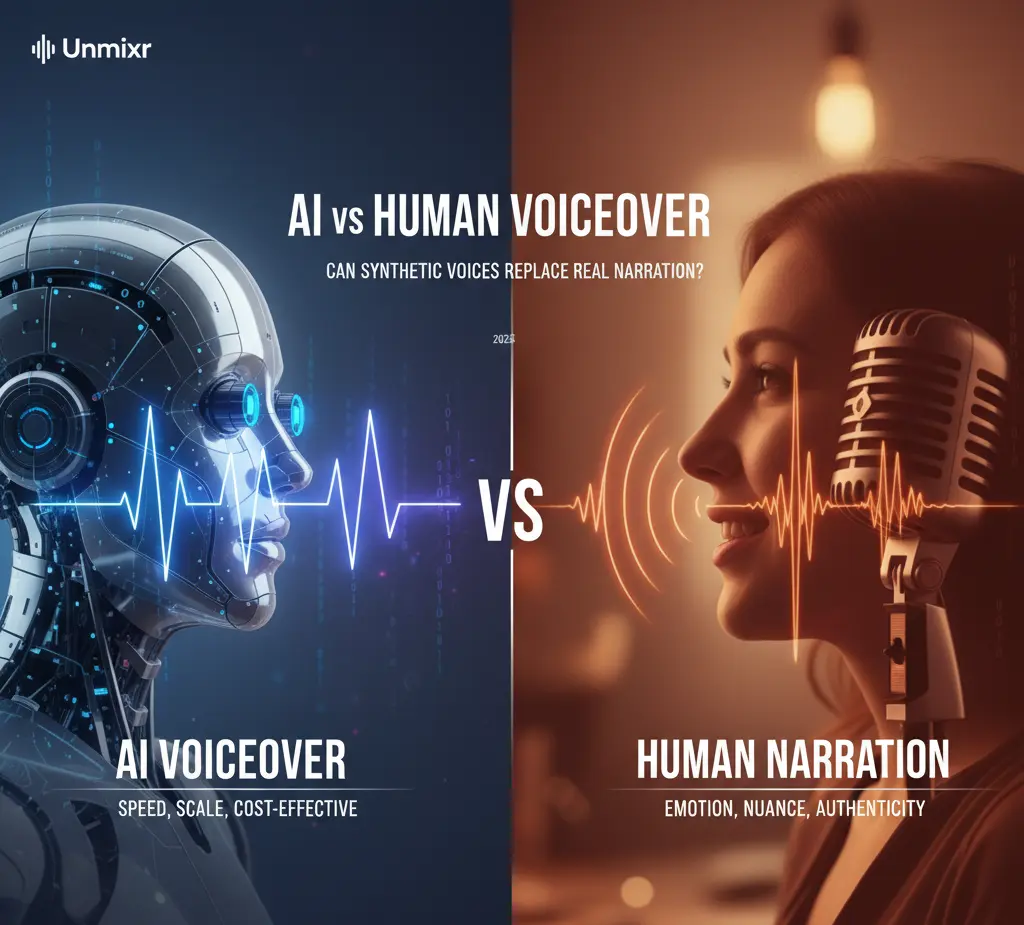Can AI Voiceovers Replace Human Narration in 2025?

The rise of AI has reshaped many industries, and the world of voiceover is no exception. In 2025, synthetic voices are no longer robotic they’re natural, expressive, and widely accessible. But the big question remains: can AI truly replace human narrators, or do humans still have an irreplaceable role in creative projects?
For brands, creators, and agencies, the answer isn’t simple. Both AI and human voiceovers offer unique advantages. The right choice depends on goals, audience expectations, and the type of project.
AI vs Human Voiceover – What’s Changing in 2025
AI-generated voices have advanced rapidly. Today, they can deliver natural tones, realistic pacing, and even subtle emotional cues. With diverse accents and language options, AI tools can adapt to global audiences in ways that were once unimaginable.
Human narration, however, continues to hold strong advantages. A skilled voice actor brings authenticity, cultural awareness, and emotional depth that AI often struggles to fully capture. Their ability to improvise and interpret content remains unmatched.
As we move into 2025, many agencies and content creators are embracing a blended approach. AI is being used for speed, scale, and budget projects, while human narrators are reserved for campaigns that require emotional storytelling and cultural nuance. For teams exploring this hybrid model, Unmixr AI offers advanced voiceover solutions designed to balance efficiency with quality.
Synthetic Voice vs Real Voice – Key Comparison Points
When comparing AI voiceovers with human narration, several key differences stand out.
Cost vs Quality: AI voiceovers are far more affordable than hiring professional talent. For startups or low-budget projects, AI offers professional-sounding narration without high fees. Human narrators, however, bring expertise and polish that can elevate high-value productions.
Turnaround Times: AI provides instant results. A script can be uploaded, and a finished voiceover is ready within minutes. Human narrators require scheduling, recording sessions, and editing time, making the process longer but often more refined.
Creative Flexibility: AI guarantees consistency every line is delivered exactly as instructed. However, humans excel at creative interpretation, adding improvisation, tone shifts, and personality that can’t always be pre-programmed.
Audience Perception: Some audiences can still detect the subtle differences in synthetic voices, especially in emotionally charged content. In contrast, human narration builds deeper trust and connection.
Brand Use Cases: AI works well in e-learning, corporate training, prototypes, and even short ads. Human voiceovers shine in audiobooks, brand storytelling, and gaming, where emotion and nuance play a central role.
When to Choose AI vs Human Narration
Not every project requires the same type of voiceover. The choice between AI and human narration depends on context, goals, and budget.
Best for AI: AI narration is perfect for explainer videos, e-learning courses, short social ads, and prototypes. These projects prioritize speed, cost-effectiveness, and consistency. AI ensures scalable content production without straining budgets.
Best for Humans: For emotional storytelling, brand identity campaigns, or high-stakes projects, human narrators remain the gold standard. Their ability to capture subtle tones, cultural meaning, and authentic emotion gives brands a competitive edge.
Hybrid Model: Many companies are adopting a hybrid approach using AI for scalable projects while hiring human narrators for premium campaigns. This model balances efficiency with authenticity and ensures the best of both worlds.
FAQs About AI Voiceovers vs Human Narration
Q1: Will AI voiceovers fully replace human narrators?
No. While AI voiceovers are advancing quickly, humans still provide nuance and creativity that machines cannot fully replicate. Both will coexist, serving different needs.
Q2: Are synthetic voices legally safe to use for brands?
Yes, as long as businesses use licensed AI tools. It’s important to ensure voice rights are clearly defined to avoid copyright or usage issues.
Q3: How much do AI voiceovers cost compared to professionals?
AI voiceovers are significantly cheaper. Many platforms charge a subscription or per-minute fee, while professional narrators charge per project or per word.
Q4: Do audiences care if narration is AI or human?
It depends on the content. For training videos or short ads, audiences may not notice or care. But for emotional stories or audiobooks, human voices are often preferred.
Q5: Can AI voiceovers capture emotion as well as humans?
AI has improved in emotional delivery, but it still struggles with subtle expression. Humans remain better at conveying genuine emotion, cultural nuance, and improvisation.
Conclusion – The Future of Voiceovers in 2025
AI voiceovers have transformed the industry by offering speed, affordability, and scalability. At the same time, human narrators continue to provide nuance, authenticity, and cultural sensitivity that machines cannot replicate. The future isn’t about one replacing the other it’s about choosing wisely based on project needs.
For some projects, AI delivers unbeatable efficiency. For others, human voices remain essential for building emotional connections. The key for brands and creators in 2025 is to view AI and human voiceovers as complementary tools within a broader creative strategy.
Contact Us Today: Explore Unmixr’s AI voice solutions and discover how synthetic narration can elevate your next project. Whether you need fast, scalable AI voices or guidance on when to blend them with human narration, our team is here to help.